If you’re looking for the 13 best semiconductor parameter analyzers for precise testing in 2025, I’ve got you covered. These include advanced spectrum analyzers, transistor curve tracers, and versatile digital multimeters designed for research, production, and educational use. Each device offers unique features like high accuracy, automation, and easy operation to meet varied testing needs. Stay tuned as I break down how these tools can enhance your testing process and guarantee reliable results.
Key Takeaways
- The list highlights top semiconductor parameter analyzers offering high accuracy, multi-device testing, and automation features for 2025 applications.
- It covers various device types including transistor analyzers, spectrum analyzers, and portable testers suitable for R&D and production.
- Key features include advanced measurement parameters, user-friendly interfaces, connectivity options, and data storage capabilities.
- The selection emphasizes precision, ease of use, compatibility, and cost-effectiveness to meet diverse testing needs.
- These analyzers support comprehensive testing modes like I-V, C-V, and RF spectrum analysis, ensuring reliable and efficient semiconductor characterization.
AURSINC Tinysa Ultra+ Spectrum Analyzer (ZS407)
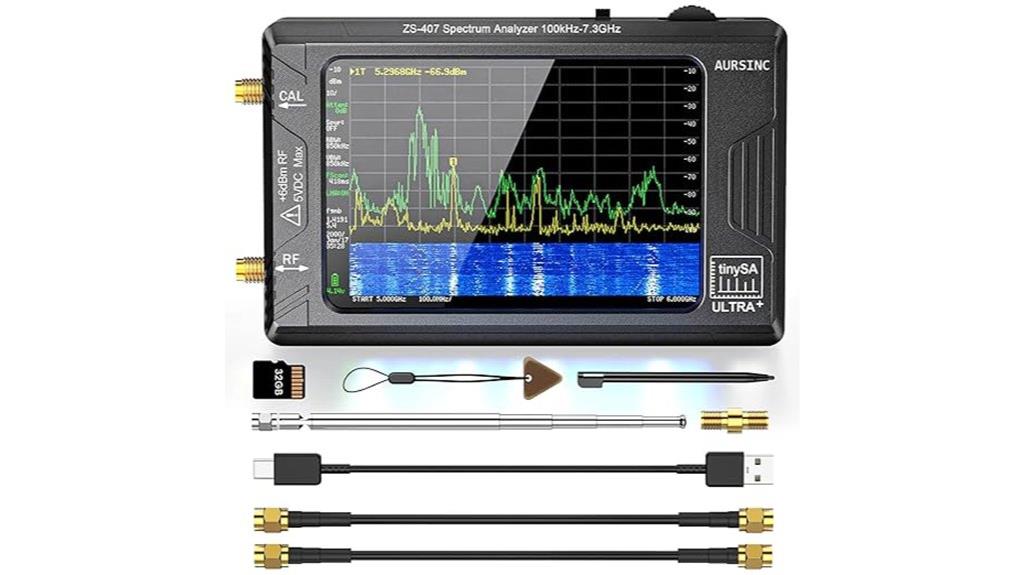
If you’re looking for a versatile and portable spectrum analyzer that’s perfect for both hobbyists and professionals, the AURSINC Tinysa Ultra+ ZS407 stands out. It covers a broad frequency range from 100kHz to 7.3GHz, with an optional upgrade up to 12GHz for capturing signals across diverse RF environments. The device features a bright 4-inch touchscreen, PC control compatibility, and on-site data storage via a 32GB micro SD card. It functions both as a spectrum analyzer and a signal generator, offering sine, square, and RF test signals. Its compact design, high sensitivity, and user-friendly interface make it ideal for troubleshooting, RF testing, and spectrum monitoring.
Best For: hobbyists and professionals seeking a portable, versatile RF spectrum analyzer with broad frequency coverage and user-friendly features.
Pros:
- Wide frequency range from 100kHz to 7.3GHz, with optional upgrade up to 12GHz for diverse signal capturing.
- Compact, portable design with a bright 4-inch touchscreen and PC control compatibility for ease of use.
- High sensitivity and low phase noise performance, ideal for precise RF measurements and troubleshooting.
Cons:
- The device’s extensive features may require some familiarization due to its complexity.
- External accessories like cables and antennas are needed for full functionality, adding to setup considerations.
- As with all RF equipment, verifying authenticity is important to avoid counterfeit units.
Transistor Curve Tracer Semiconductor Parameter Analyzer with LCD Screen
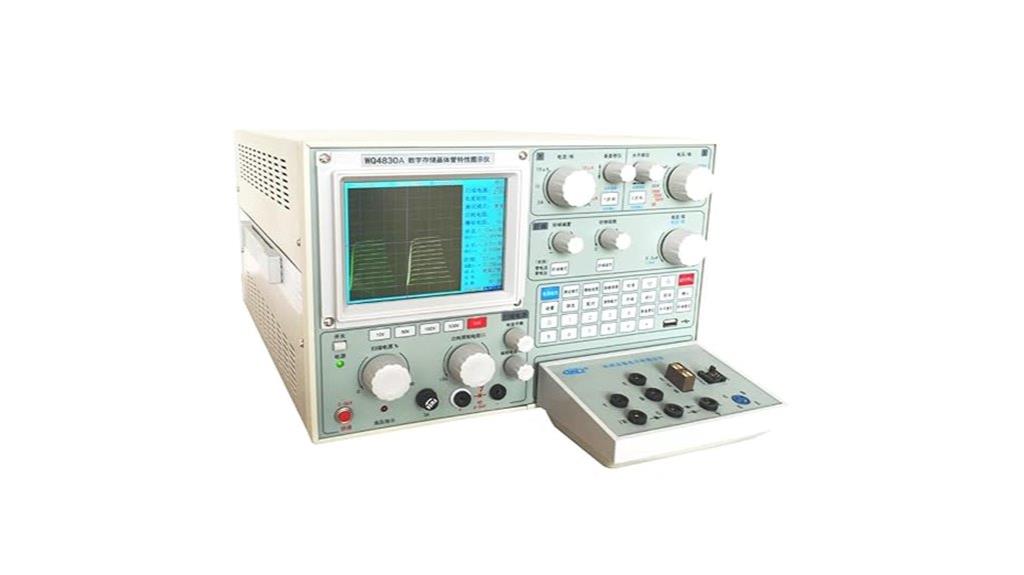
The Transistor Curve Tracer Semiconductor Parameter Analyzer with LCD Screen stands out for its intuitive user interface and extensive measurement capabilities, making it ideal for engineers and technicians seeking precision testing. Its 640 × 480 TFT color LCD provides clear visuals, while the English operation system guarantees ease of use. It measures voltage, current, β, and gm, with automatic parameter settings and display. Supporting a broad current range from 10μA to 50A, it offers flexible testing. Data storage is versatile, with internal capacity for 10 graphics and unlimited transfer via USB. Alerts for parameter limits and real-time graphics display enhance testing accuracy and efficiency.
Best For: engineers and technicians seeking precise, easy-to-use transistor testing and parameter analysis with comprehensive data management.
Pros:
- User-friendly 640 × 480 TFT LCD display ensures clear visuals and easy operation
- Wide measurement range supporting voltage, current, β, and gm with automatic settings
- Unlimited data transfer and storage via USB, with options for graphics and image saving
Cons:
- May have a higher cost due to advanced features and large display
- Limited internal storage for graphics (up to 10), requiring USB for extensive data management
- Requires familiarity with electronic testing to fully utilize all measurement capabilities
C-V Analyzer Semiconductor Parameter Testing System
For professionals focused on semiconductor power device analysis, the C-V Analyzer Semiconductor Parameter Testing System stands out with its all-in-one, highly integrated design. It combines an LCR meter, VGS/VDS voltage sources, and a switching matrix, enabling quick, accurate testing of diodes, transistors, MOSFETs, IGBTs, and power modules. Supporting parallel testing of up to six devices, it simplifies production line and R&D workflows. Its intuitive 10.1-inch touchscreen displays test results alongside circuit diagrams and sorting data. With a broad measurement range, versatile C-V curve analysis, and rapid one-touch operation, this system assures efficient, precise characterization of power devices.
Best For: professionals engaged in semiconductor power device analysis, R&D, production testing, and material characterization seeking an integrated, rapid, and precise testing solution.
Pros:
- Combines multiple measurement functions including LCR, VGS/VDS sources, and switching matrix in one compact system.
- Supports parallel testing of up to 6 devices, enhancing throughput and efficiency.
- User-friendly 10.1-inch touchscreen interface simplifies operation and data visualization.
Cons:
- May require initial training to fully leverage advanced features and test setups.
- The high level of integration could result in a higher initial investment compared to simpler testers.
- Limited to certain device types; may not be suitable for non-power or specialized semiconductor components.
iDili Digital Transistor Analyzer Tester
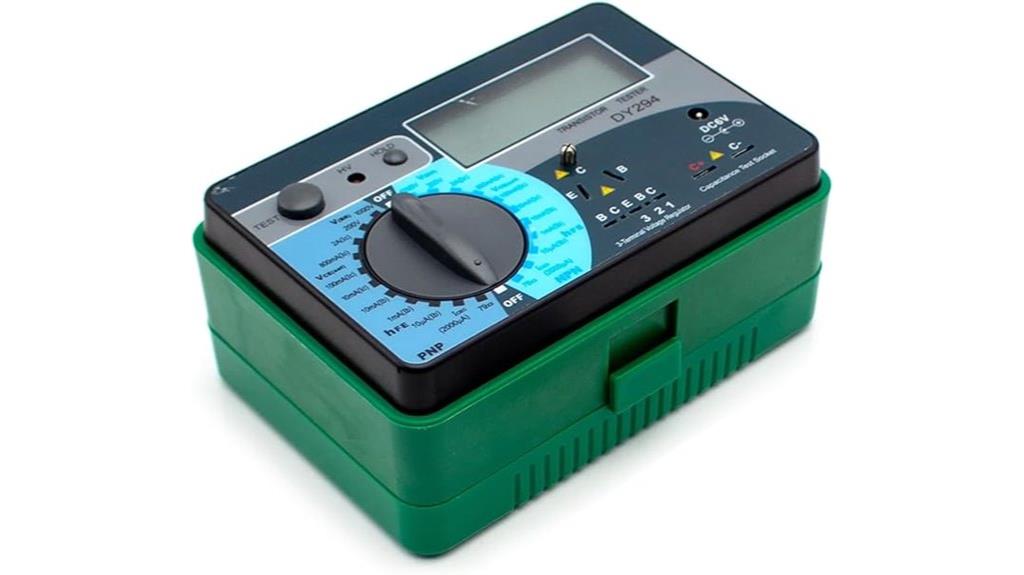
The iDili Digital Transistor Analyzer Tester (Model DY294) stands out as an ideal choice for electronics enthusiasts and technicians who need a versatile device to accurately test a wide range of semiconductors and passive components. It measures DC parameters of diodes, transistors, SCRs, and FETs, including forward voltage, reverse voltage, and leakage current. Beyond semiconductors, it evaluates capacitors, varistors, and voltage regulators, making it highly adaptable. Its compact design, weighing just 1.8 pounds, ensures portability and ease of use. Since its release in September 2023, the DY294 has gained popularity for extensive testing capabilities in repair, maintenance, and development projects.
Best For: electronics enthusiasts, technicians, and repair professionals seeking a versatile, portable device to accurately test semiconductors and passive components.
Pros:
- Comprehensive measurement capabilities for diodes, transistors, SCRs, FETs, capacitors, and varistors
- Compact and lightweight design (1.8 pounds) for easy portability and handling
- No batteries required, simplifying operation and maintenance
Cons:
- Limited to digital testing within specified ranges; may not support all high-voltage or specialized components
- Availability and support might be limited depending on regional distribution
- Does not include detailed graphical analysis or advanced data logging features
AstroAI Digital Multimeter and Analyzer (TRMS 6000 Counts)
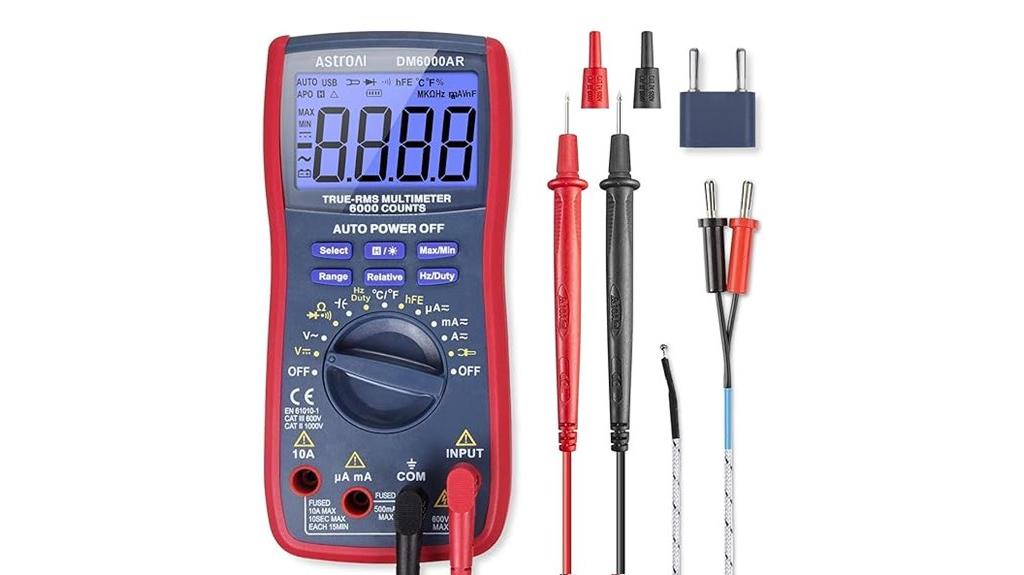
If you’re looking for a versatile and user-friendly multimeter, the AstroAI Digital Multimeter and Analyzer with TRMS 6000 Counts stands out as an excellent choice. It measures AC/DC Voltage, Current, Resistance, Capacitance, Frequency, Duty Cycle, Diodes, Continuity, and Temperature with true RMS accuracy, ensuring precise readings. Its auto-ranging feature simplifies testing, while the large backlit LCD makes it easy to read results in any environment. Safety is prioritized with double ceramic fuses that handle overloads safely. Perfect for troubleshooting automotive or household electrical issues, it’s a reliable tool for both professionals and DIY enthusiasts. Plus, professional support is just a call away.
Best For: DIY enthusiasts, automotive technicians, and household electricians seeking a reliable, versatile multimeter for accurate electrical measurements and troubleshooting.
Pros:
- Measures AC/DC Voltage, Current, Resistance, Capacitance, Frequency, Duty Cycle, Diodes, Continuity, and Temperature with True RMS accuracy
- User-friendly features including auto-ranging, data hold, large backlit LCD, and auto shut-off for convenience
- Safe to use with double ceramic fuses that provide overload protection and prevent burns or explosions
Cons:
- Proper operation requires removing test lead caps and consulting the manual for safety and usage instructions
- May be more expensive than basic multimeters with fewer features
- Requires careful handling of the fuses and adherence to safety guidelines for optimal performance
UTE9800 UTE9901 Digital Power Meter with Alarm Functions
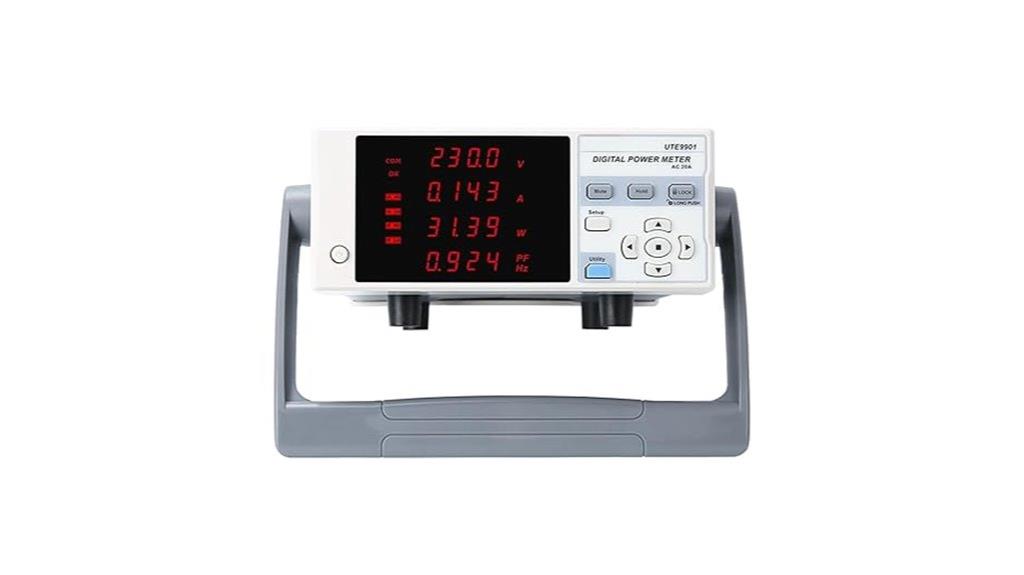
The UTE9800 UTE9901 Digital Power Meter stands out as an ideal choice for professionals who need reliable, real-time electrical measurements with integrated alarm functions. This portable, multifunctional device measures voltage, current, power, power factor, and frequency with true RMS accuracy, ensuring dependable readings. Its preset upper and lower limits for current and power trigger audible and visual alarms when exceeded, enhancing safety and monitoring. The user-friendly interface includes data saving, screen lock, and mute functions, making it simple to set and track parameters. Cost-effective and versatile, it’s perfect for various testing environments and critical applications.
Best For: professionals and technicians who require accurate, real-time electrical measurements with integrated alarm functions for safety and monitoring purposes.
Pros:
- True RMS measurement ensures precise and reliable readings of voltage, current, and power.
- Alarm functions with preset limits provide proactive safety alerts through audible and visual signals.
- User-friendly interface with data saving, screen lock, and mute options enhances ease of use and setup.
Cons:
- May be limited in advanced data analysis features compared to more complex instrumentation.
- Portable design might compromise some functionalities found in larger, stationary meters.
- The device’s cost-effectiveness could mean fewer high-end features for specialized applications.
High Accuracy Transistor Analyzer for Research & Development
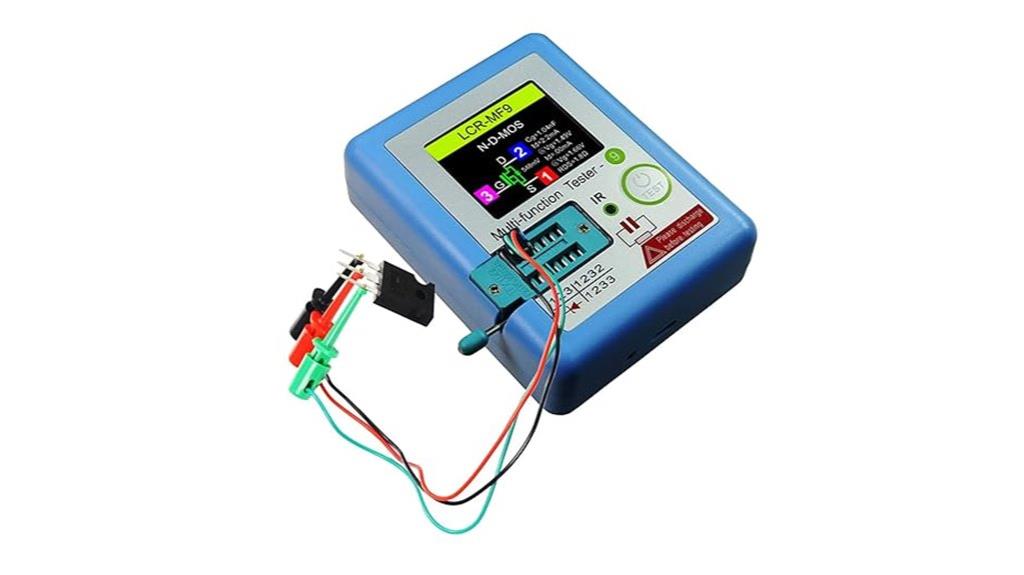
Engineers and researchers seeking reliable, high-precision testing tools will find the LCRMF9 Transistor Tester indispensable for R&D. This compact device delivers quick, accurate measurements of key transistor parameters like current gain and cutoff frequency. Its automatic identification feature supports multiple transistor types, ensuring stable results across various components. Built from durable ABS material, it withstands demanding laboratory and manufacturing environments. The LCRMF9’s user-friendly interface and rapid response make detailed analysis efficient, while its accuracy enhances development, diagnostics, and quality control. Overall, it’s an essential instrument for anyone focused on advancing electronic component research and ensuring ideal performance.
Best For: electronics engineers, researchers, and manufacturers seeking high-precision, reliable transistor testing in R&D, diagnostics, and quality control.
Pros:
- High accuracy and rapid response for efficient testing
- Supports multiple transistor types with automatic identification
- Durable ABS construction suitable for demanding environments
Cons:
- Manual measurement may introduce errors of 1 to 3cm
- Slight variations in monitor displays can affect color appearance
- Compact size may limit the handling of larger or specialized components
High Accuracy Transistor Analyzer for Research
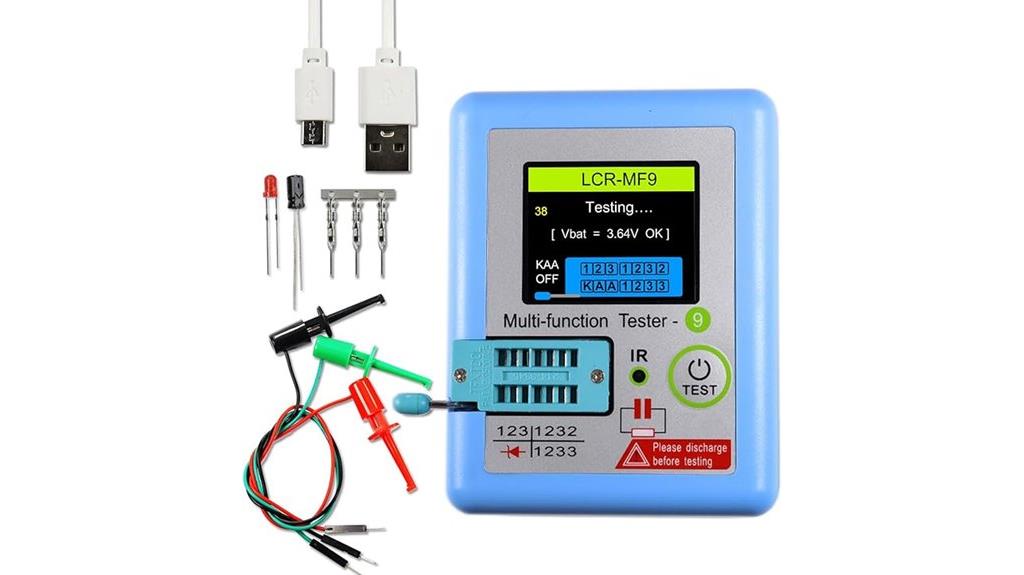
A standout choice for research environments is the High Accuracy Transistor Analyzer model LCRMF9, thanks to its automatic transistor identification system. I’ve found it invaluable for precise measurements of current gains and cutoff frequencies, ensuring reliable results every time. Its rapid response accelerates testing workflows, while its user-friendly interface makes complex diagnostics straightforward. Built with durable ABS material, it withstands demanding lab conditions. Whether in R&D, manufacturing, or educational settings, this analyzer provides consistent performance, helping researchers and engineers achieve accurate, repeatable measurements essential for advancing electronic component development.
Best For: electronic engineers, researchers, and manufacturers involved in developing, testing, or maintaining electronic components in research, development, or educational settings.
Pros:
- High accuracy and reliable measurements for transistor parameters
- Rapid response time to accelerate testing workflows
- User-friendly interface with automatic transistor identification system
Cons:
- May require training for optimal operation due to advanced features
- Limited to transistor testing, not suitable for other electronic components
- Constructed with ABS material, which, while durable, may be less resistant to extreme environmental conditions
DSO-TC4 Upgraded 3-in-1 Portable Oscilloscope
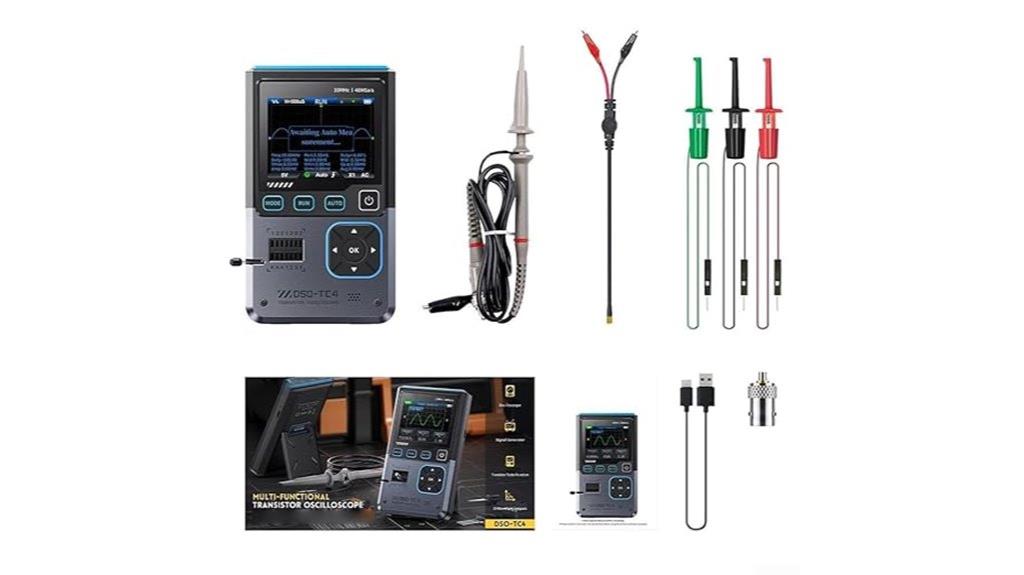
If you’re seeking a versatile testing tool that combines multiple functions into a compact device, the DSO-TC4 Upgraded 3-in-1 Portable Oscilloscope stands out. It merges an oscilloscope, electronic component tester, and DDS signal generator into one handheld unit, offering portability and convenience. With a 10MHz analog bandwidth and 48MSa/s sampling rate, it provides accurate, reliable signal measurements. The 8-inch color TFT display makes monitoring easy, while adjustable parameters like frequency and amplitude allow customized testing. Perfect for troubleshooting semiconductors, transistors, diodes, and other components, this device boosts testing efficiency without sacrificing precision.
Best For: electronics technicians, engineers, and enthusiasts seeking a compact, all-in-one tool for precise testing and signal analysis.
Pros:
- Combines oscilloscope, electronic component tester, and signal generator in one portable device
- High accuracy with 10MHz bandwidth and 48MSa/s sampling rate
- User-friendly 8-inch color TFT display with adjustable testing parameters
Cons:
- Limited to 10MHz analog bandwidth, which may not suit high-frequency applications
- Handheld design might be less suitable for extended use or stationary setups
- May require familiarity with electronic testing for optimal operation
United Scientific™ CNDT01, Electric Conductivity Tester
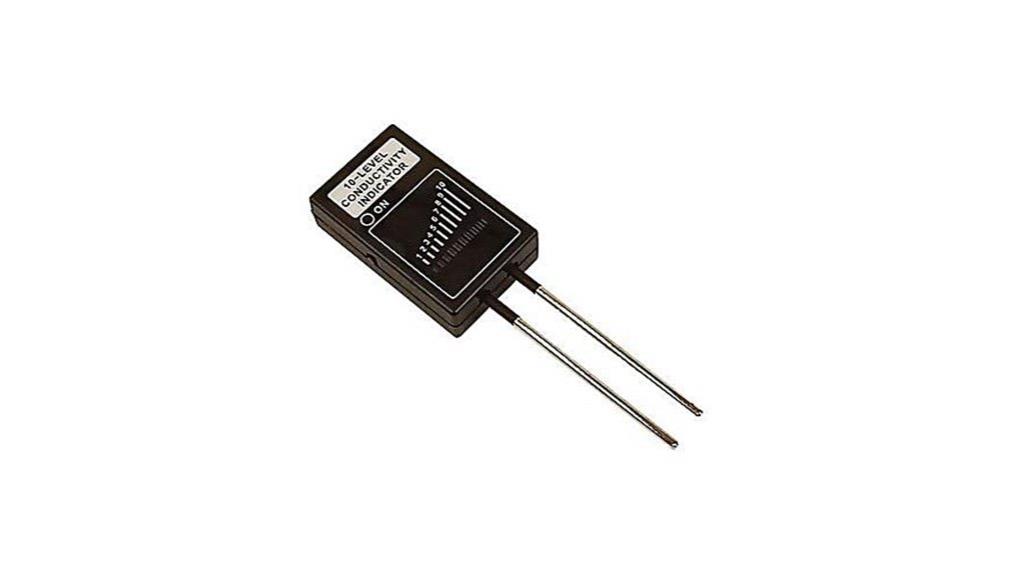
The United Scientific™ CNDT01 Electric Conductivity Tester stands out as an excellent choice for educators and students seeking a simple, reliable tool for qualitative solution testing. Its handheld design, with brass probes and clear LED indicators, makes it easy to evaluate conductivity levels quickly. The device effectively distinguishes ionic, polar covalent, and non-polar substances, offering straightforward visual results. Despite some limitations with the LED system, it’s durable, easy to clean, and affordable, making it perfect for classroom demonstrations and experiments. Overall, it’s a dependable and user-friendly tester that balances performance and cost, ideal for educational environments.
Best For: educators and students seeking an affordable, easy-to-use qualitative solution conductivity tester for classroom and laboratory experiments.
Pros:
- Simple push-button operation and clear LED indicators for quick results
- Durable, easy-to-clean design ideal for educational environments
- Effectively distinguishes between ionic, polar covalent, and non-polar substances
Cons:
- A reading of 1 does not necessarily mean no conductivity, which can be confusing
- Some units may show immediate LED activity after battery installation, regardless of solution conductivity
- LED indicator system may be misleading for non-conductive substances, requiring additional explanation
Transistor Tester for Educational Labs
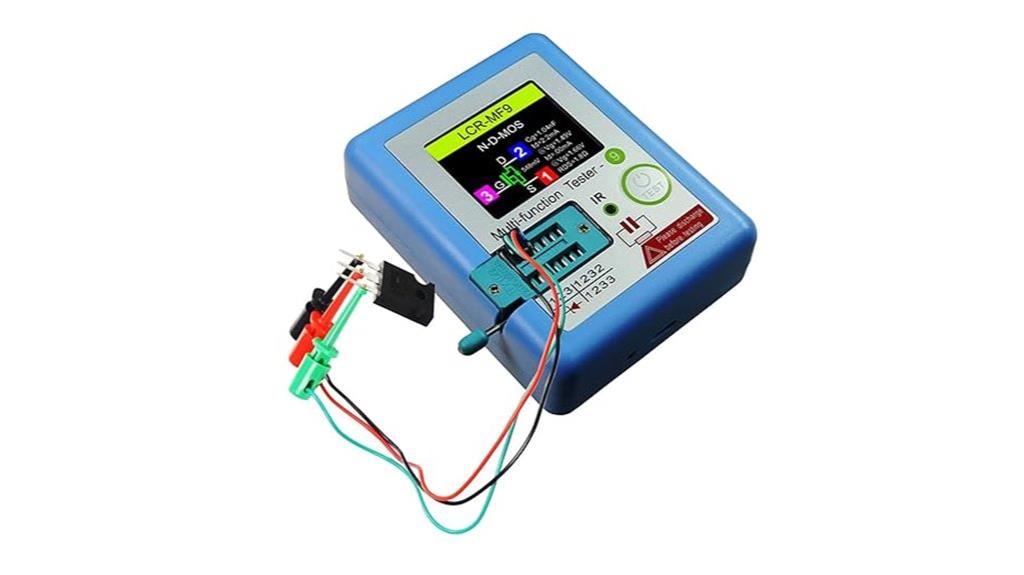
Educational laboratories need reliable tools to accurately evaluate transistor performance, and the Precise Transistor Tester LCRMF9 stands out with its automatic identification of multiple transistor types. I find it invaluable for teaching and hands-on learning, as it quickly measures key parameters like current gain and cutoff frequency. Its high accuracy, fast response, and user-friendly interface make testing straightforward, even for beginners. Built with durable ABS, it’s portable and robust, perfect for classroom or lab environments. This tester not only improves diagnostics but also reinforces fundamental electronics concepts, making it an essential educational tool for developing students’ understanding of transistor performance.
Best For: educational laboratories, electronics teachers, and students seeking a reliable, easy-to-use transistor testing tool for learning and practical assessments.
Pros:
- Supports multiple transistor types with automatic identification for versatile testing
- High accuracy and rapid response enhance diagnostic efficiency
- Durable ABS construction makes it portable and suitable for frequent use in educational settings
Cons:
- Manual measurements may introduce a 1-3cm error in readings
- Color display variations may occur due to monitor differences
- Requires proper handling to ensure long-term device performance
KP182 KP184 DC Electronic Load Meter (KP184)
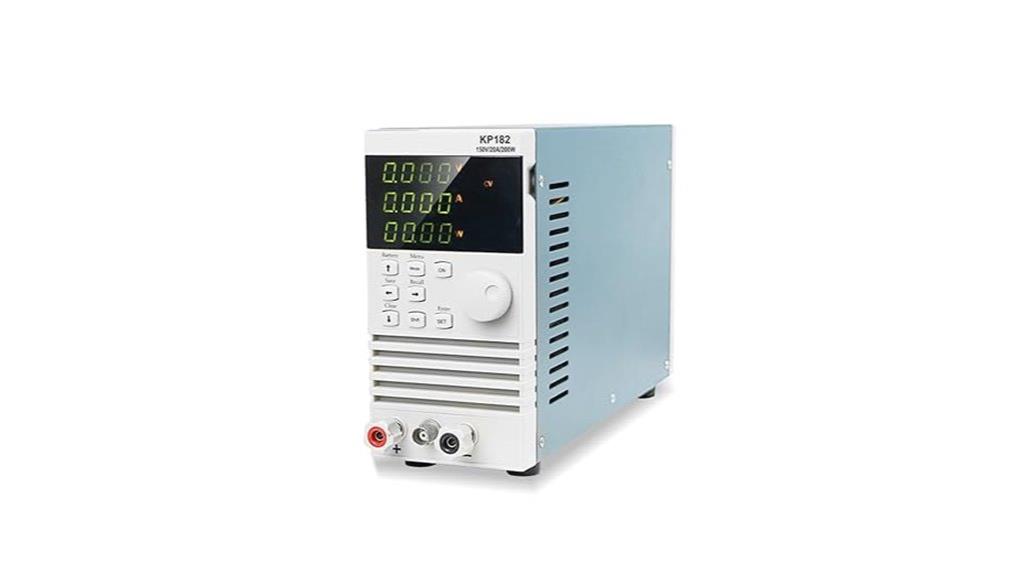
For professionals seeking high-precision electronic loads, the KP184 model stands out with its ability to handle load currents up to 40A and deliver power up to 400W, making it ideal for testing large batteries, power supplies, and chargers. It offers exceptional measurement accuracy of ±0.05%+5mA for current and ±0.05%+5mV for voltage, ensuring reliable results. The device is easy to operate, with straightforward adjustments and built-in protection functions that enhance safety and durability. Its compact size and low power consumption make it suitable for various laboratory and industrial environments, streamlining testing processes while maintaining precision.
Best For: professionals requiring high-precision testing and aging of batteries, power supplies, and chargers in laboratory or industrial settings.
Pros:
- Exceptional measurement accuracy of ±0.05%+5mA (current) and ±0.05%+5mV (voltage), ensuring reliable results.
- Supports high load currents up to 40A and power up to 400W, suitable for large batteries and power sources.
- Compact design with easy operation, straightforward adjustments, and built-in protection functions for safety and durability.
Cons:
- No communication functions included in the standard model, limiting remote control options.
- Requires a power input fuse rated at 0.5A, which may need periodic replacement.
- Operating temperature range is limited to 0°C to 50°C, potentially restricting use in extreme environments.
Air Quality Monitor, Gas and Particle Detector
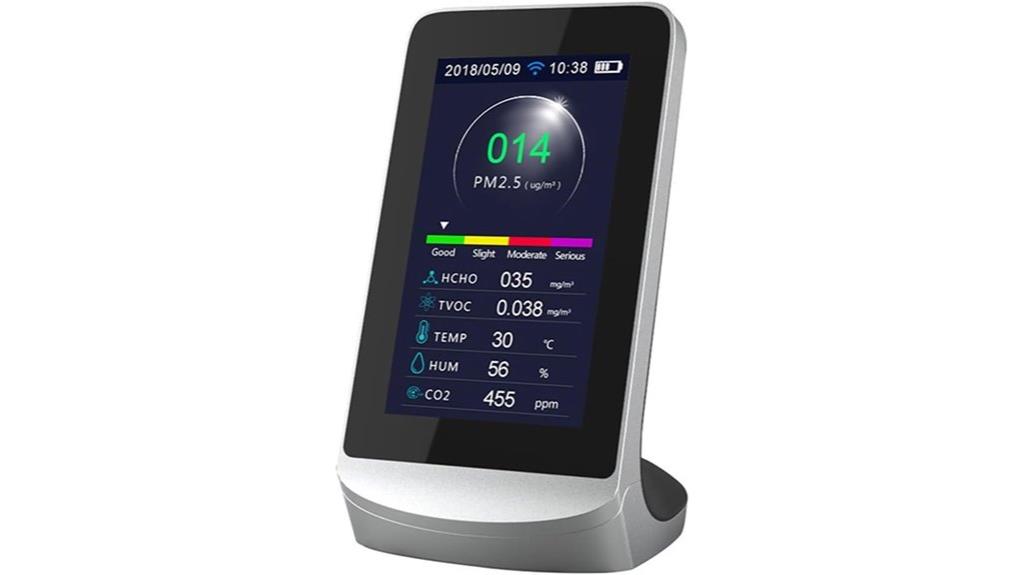
If you need reliable, real-time air quality data, this device stands out thanks to its advanced multi-sensor technology and built-in fan, ensuring highly accurate measurements. It detects parameters like PM2.5, formaldehyde, TVOC, CO2, and other gases with precision, providing detailed insights into indoor air quality. The user-friendly LCD display makes data interpretation straightforward, while its compact, portable design allows flexible placement across various indoor environments. Regular use helps protect health by monitoring pollutants that can cause respiratory issues and allergies. Overall, this monitor offers an efficient, scientific way to maintain a safe, healthy living or working space.
Best For: individuals and organizations seeking accurate, real-time indoor air quality monitoring to protect health and ensure a safe environment.
Pros:
- Employs advanced multi-sensor technology for precise measurements of multiple air pollutants.
- Features a clear, user-friendly LCD display for easy data interpretation.
- Compact and portable design allows flexible placement in various indoor settings.
Cons:
- May require regular calibration to maintain measurement accuracy over time.
- The device’s advanced sensors and features could be relatively costly compared to basic monitors.
- Limited to indoor use; not suitable for outdoor air quality assessment.
Factors to Consider When Choosing Semiconductor Parameter Analyzers

When selecting a semiconductor parameter analyzer, I focus on measurement range and accuracy to guarantee precise results. I also consider device compatibility and ease of use, so the tool integrates smoothly into my workflow. Finally, budget constraints and data connectivity options influence my final choice for the best fit.
Measurement Range and Accuracy
Choosing the right semiconductor parameter analyzer hinges on understanding its measurement range and accuracy. I look for analyzers that cover the specific parameters I need, such as VGS, VDS, capacitance, or current gain, guaranteeing they suit my device types. High measurement accuracy, expressed in percentage or ppm, is critical for reliable results, especially in R&D. I pay attention to the noise floor and detection limits, like DANL, to ensure weak signals are measurable. Matching the analyzer’s frequency range and resolution to my device’s signals prevents data loss or inaccuracies. Additionally, I verify that the instrument can be calibrated consistently and is traceable to recognized standards, maintaining measurement integrity over time. These factors guarantee precise, dependable testing outcomes.
Device Compatibility and Versatility
Selecting a semiconductor parameter analyzer requires guaranteeing it can handle the specific device types I work with, such as diodes, transistors, MOSFETs, and IGBTs. I verify that the system supports these components and is compatible with my existing testing environment, including electrical interfaces, voltage and current ranges, and software integration. Multi-device testing capabilities are also important, as they boost throughput by testing multiple components simultaneously. Additionally, I check if the analyzer offers a broad frequency range and various parameter measurement options for thorough device characterization. Connectivity features like USB or Ethernet are essential for data management and integration with external instruments or computers. Overall, device compatibility and versatility ensure I can perform accurate, efficient testing across diverse semiconductor devices.
Ease of Use and Interface
A semiconductor parameter analyzer with an intuitive and user-friendly interface makes testing much more efficient and less prone to errors. Features like touchscreens or clear menu layouts simplify operation and reduce training time, allowing users to get started quickly. Support for multiple languages and customizable display options enhance accessibility for diverse teams. Visual aids, such as graphical parameter displays and real-time data visualization, help interpret complex semiconductor characteristics faster. Automated measurement features and limit-setting functions streamline testing, minimizing manual input and user mistakes. Compatibility with external devices, like PCs or data loggers, ensures seamless data transfer and all-encompassing analysis. Overall, a well-designed interface not only boosts productivity but also enhances accuracy, making it a vital factor when selecting a parameter analyzer.
Data Storage and Connectivity
When evaluating semiconductor parameter analyzers, it’s vital to take into account their data storage and connectivity options, as these features directly impact workflow efficiency and data management. Many analyzers offer internal memory, external SD cards, or USB interfaces, making data transfer straightforward. High-speed USB, Ethernet, and wireless options enable real-time data transfer and remote monitoring, saving time and reducing errors. The ability to export data in formats like CSV, JPG, or BMP streamlines analysis, reporting, and documentation. Some models support computer control software, facilitating automated testing, data logging, and complex analysis. Reliable connectivity ensures smooth integration with laboratory systems, enhancing overall testing efficiency. Prioritizing these features helps guarantee your analyzer meets your data management needs and supports seamless workflow operation.
Price and Budget Considerations
Price and budget considerations play a crucial role in choosing the right semiconductor parameter analyzer, as these devices can vary considerably in cost. Setting a clear budget helps narrow options and ensures you pick a model that balances affordability with necessary measurement features. Keep in mind the total cost of ownership, including accessories, calibration, maintenance, and software updates, which can add up over time. While higher-priced analyzers often provide better accuracy, higher resolution, and advanced features suited for research or industrial use, they may not be necessary for all applications. Comparing features relative to price helps identify the best value, ensuring you get a device that meets your testing needs without overspending. Smart budgeting leads to more effective, cost-efficient testing setups.
Frequently Asked Questions
What Are the Key Specifications to Compare in Semiconductor Parameter Analyzers?
When comparing semiconductor parameter analyzers, I focus on key specs like voltage and current ranges, measurement accuracy, and resolution. I also look at test speed, automation features, and user interface ease. Additionally, I consider the device’s stability, repeatability, and compatibility with different device types. These factors help me determine which analyzer offers precise, reliable testing suited to my specific needs.
How Do Measurement Accuracy and Repeatability Impact Testing Results?
Measurement accuracy and repeatability are vital because they determine the reliability of my testing results. Accurate measurements ensure I get true data on device performance, while repeatability confirms I can reproduce results consistently. If either is off, my tests might lead to false conclusions, impacting quality and development. So, I always prioritize analyzers that deliver high accuracy and consistent results to make confident decisions.
Which Features Are Essential for High-Throughput Semiconductor Testing?
When it comes to high-throughput semiconductor testing, I believe speed and automation are everything. You need a parameter analyzer with lightning-fast data acquisition, real-time analysis, and seamless integration with automated test systems. Robust multi-channel capabilities, high resolution, and advanced software for quick diagnostics are must-haves. These features make sure I can test thousands of devices efficiently without sacrificing accuracy, keeping production lines moving at an unstoppable, almost superhuman pace.
How Does User Interface Influence Testing Efficiency and Ease of Use?
A user-friendly interface greatly impacts testing efficiency and ease of use. I find that intuitive navigation, clear visualizations, and customizable controls help me work faster and reduce errors. When the interface is straightforward, I spend less time figuring out functions and more time focusing on testing. A well-designed UI boosts confidence, minimizes training time, and makes sure I can operate the analyzer accurately and efficiently, especially under tight schedules.
What Are the Maintenance and Calibration Requirements for These Analyzers?
Maintaining semiconductor analyzers is like tending a garden — regular care keeps everything thriving. I follow manufacturer guidelines closely, performing routine calibration checks using standard reference devices to guarantee accuracy. I also clean connections and inspect for wear periodically. Calibration typically happens quarterly or after any major repair. Staying diligent with these steps keeps the analyzer’s performance sharp, ensuring precise testing results that I can trust.
Conclusion
Choosing the right semiconductor parameter analyzer is like finding the perfect needle in a haystack, but with the right tools, it becomes a breeze. Whether you need precision, ease of use, or versatility, these top options in 2025 have got you covered. Think of it as opening a treasure chest of accuracy and reliability—your secret weapon for flawless testing. Immerse yourself, explore, and find the perfect match to elevate your testing game!








